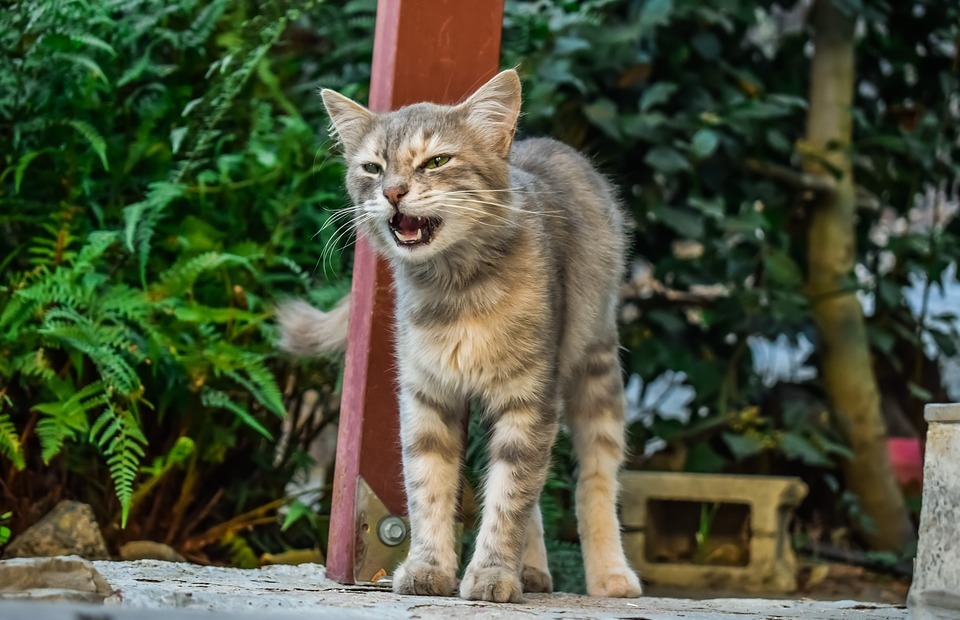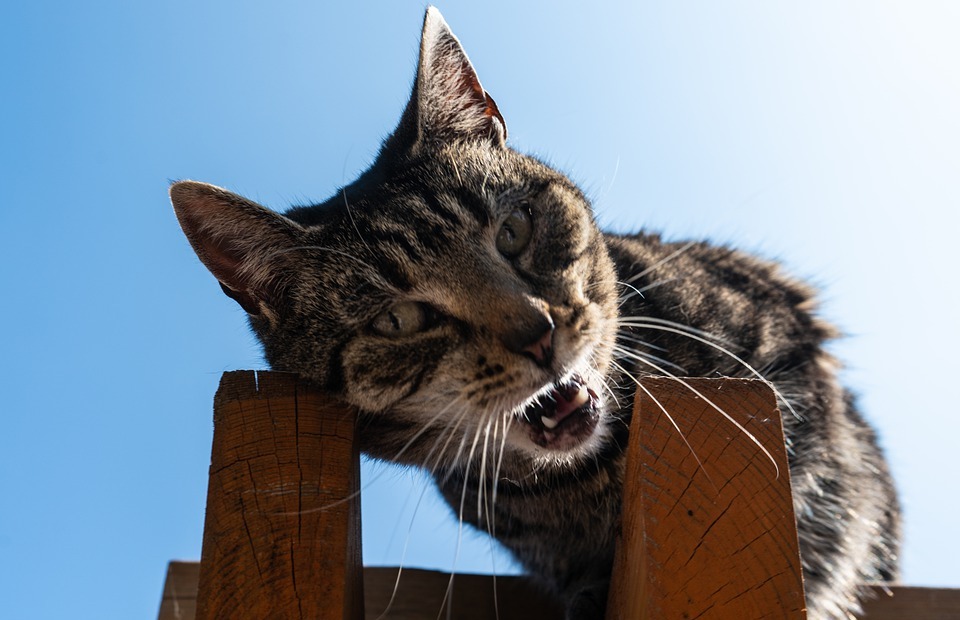This article delves into the fascinating world of feline vision, exploring the common misconception that cats can see perfectly in the dark. We will examine the unique adaptations that enable cats to see in low-light conditions, uncovering the truth behind their remarkable night vision. By understanding the science behind their visual capabilities, we can appreciate the true extent of their ability to navigate the world in darkness.
Part 1: The Truth Behind Feline Night Vision

1.1 Debunking the Myth: The Power of Perception
- The popular belief that cats can see perfectly in the dark is a myth, often fueled by our perception of their nocturnal prowess.
- We see them confidently moving around in dimly lit spaces, hunting effectively at night, leading us to believe they can see in complete darkness.
- However, this perception is based on our limited understanding of feline vision and their remarkable ability to adapt to low-light conditions.
1.2 The Science of Feline Vision: Specialized Structures for Low-Light Vision
- Cats possess a unique combination of anatomical features that enhance their vision in low-light conditions.
- Their retinas have a significantly larger number of rod cells compared to human retinas. These rod cells are responsible for detecting light, crucial for vision in low light.
- Cats have a reflective layer behind their retinas called the tapetum lucidum, a highly reflective tissue that amplifies incoming light.
- This layer acts like a mirror, reflecting light back through the retina, effectively increasing the amount of light that reaches the rod cells, boosting their sensitivity and enhancing their ability to see in low light.
1.3 A Deeper Dive: The Role of the Tapetum Lucidum
- The tapetum lucidum, named for its shimmering appearance, is a thin layer of cells located behind the retina.
- It is composed of crystals of a substance called guanine, a chemical found in fish scales and some insects.
- These crystals reflect light back through the retina, allowing the rod cells to capture a greater amount of light, which enhances their ability to see in low-light conditions.
- This reflection is what causes cats' eyes to appear to "glow" in the dark when a light source is shone on them.
1.4 Visual Acuity and Colour Perception: A Trade-Off for Night Vision
- While cats have exceptional night vision, their visual acuity, the ability to see fine details, is lower than that of humans.
- This is because the dominance of rod cells, essential for low-light vision, comes at the expense of cone cells, which are responsible for colour vision and detail perception.
- Cats are dichromats, meaning they see a limited range of colours, primarily shades of blue and green.
- However, their ability to perceive motion and detect subtle changes in light, critical for hunting and navigating, is exceptional.
Part 2: The Advantages of Feline Night Vision

2.1 Hunting and Predation: The Silent Predator
- Exceptional night vision is crucial for cats' nocturnal hunting habits, making them silent and effective predators.
- They can detect prey movement in low-light conditions, allowing them to stalk their targets without being detected.
- Their sensitive vision enables them to ambush their prey in the darkness, where their prey is most vulnerable.
- The ability to see in low-light conditions gives them a significant advantage over prey species, allowing them to hunt more effectively and secure food sources.
2.2 Navigation and Orientation: Finding Their Way in Darkness
- Cats rely on their night vision to navigate their surroundings, particularly in unfamiliar environments.
- Their ability to see in low-light conditions helps them avoid obstacles, locate familiar landmarks, and find their way around in the dark.
- This is particularly important for cats that explore their territories at night or venture into dimly lit spaces.
- Their exceptional sensitivity to light allows them to perceive subtle changes in the environment, which helps them navigate even in challenging conditions.
2.3 Communication and Social Interaction: Subtle Signals in Dim Light
- Cats communicate through body language and facial expressions, which can be perceived more effectively in low light.
- Their sensitive vision allows them to detect subtle changes in expression, posture, and movement, enhancing their communication skills, even in low-light conditions.
- This ability is crucial for maintaining social bonds, navigating complex social interactions within their groups, and understanding the intentions of other cats.
- It enables them to communicate effectively in dim light, essential for coordinating social behaviours and maintaining harmony within their communities.
Part 3: The Impact of Artificial Light

3.1 Light Pollution and Its Effects: Disrupting Natural Rhythms
- Artificial light pollution can disrupt cats' natural nocturnal rhythms and affect their vision.
- Excessive exposure to artificial light, particularly at night, can suppress the production of melatonin, a hormone essential for sleep regulation.
- This can lead to sleep disturbances, restlessness, anxiety, and behavioural changes in cats, including decreased hunting success and altered social behaviours.
- The disruption of their natural rhythms can impact their overall health and well-being, highlighting the importance of creating dark spaces for their rest and relaxation.
3.2 Adapting to Urban Environments: Living in a World of Lights
- Cats living in urban environments have adapted to artificial light sources, but their vision may be compromised.
- The constant exposure to artificial light can lead to a decrease in the sensitivity of their rod cells, making them less effective in low-light conditions.
- They may experience difficulty seeing in dark spaces or navigating environments with excessive light variation, which can impact their hunting success and ability to explore their surroundings safely.
- This adaptation may come at a cost, potentially affecting their overall health and well-being, highlighting the need for creating dark spaces in urban environments for cats to retreat and maintain their natural rhythms.
Part 4: The Evolution of Feline Night Vision
4.1 Evolutionary Adaptations: Shaped by Survival and Success
- Feline night vision evolved over millions of years to suit their nocturnal lifestyle and provide them with a survival advantage in low-light conditions.
- The development of rod cells, the tapetum lucidum, and other visual adaptations gave them a significant edge in their nocturnal world.
- These adaptations allowed them to hunt effectively in darkness, avoiding predators, securing food sources, and increasing their chances of survival and reproduction.
- The evolution of their visual system is a testament to the power of natural selection, shaping their capabilities to suit their environment and ensure their continued success.
4.2 The Role of Natural Selection: Favouring the Best Hunters
- Natural selection played a crucial role in shaping feline vision, favoring individuals with better night vision.
- Cats with more sensitive eyes, enhanced by the tapetum lucidum and a larger number of rod cells, were more successful hunters, capturing prey and surviving in their environments.
- These advantageous traits were passed on to their offspring, becoming more prevalent in the feline population over time.
- The process of natural selection led to the remarkable adaptations that we see in cats today, ensuring their survival and success as nocturnal predators.
Part 5: The Myth of Cats Seeing in the Dark Explained
5.1 The Power of Perception: Reality Versus Myth
- The myth of cats seeing perfectly in the dark stems from our perception of their capabilities and our limited understanding of their visual system.
- We see their ability to navigate dimly lit spaces and hunt effectively at night and incorrectly assume they can see in complete darkness.
- This perception is fueled by the remarkable adaptations they have developed for low-light vision, making it seem like they can see in total darkness, when in reality they still need some light to perceive their surroundings.
5.2 The Importance of Scientific Evidence: Dispelling Myths and Understanding Reality
- Scientific research has debunked the myth, revealing the true nature of feline vision, a testament to the power of science to dispel common misconceptions.
- Studies have shown that cats require some light, even if it is faint and imperceptible to humans, to see their surroundings.
- Understanding the scientific evidence is crucial for dispelling common myths, appreciating the unique adaptations of cats, and developing a more accurate and realistic understanding of their remarkable capabilities.
FAQs
1. Can cats see in the dark better than humans?
Yes, cats have significantly better night vision than humans due to their larger number of rod cells and the presence of the tapetum lucidum. However, they cannot see in complete darkness; they still need some light, even if it is faint, to perceive their surroundings.
2. What colour do cats see the world in?
Cats are dichromats, meaning they see a limited range of colours, primarily shades of blue and green. They lack the cone cells required for perceiving the full spectrum of colours that humans can.
3. Do cats' eyes glow in the dark?
The tapetum lucidum in cats' eyes reflects light back, causing their eyes to glow in the dark when a light source is shone on them. This is not a form of light emission but rather a reflection of external light.
4. How do cats see in low-light conditions?
Cats have a higher concentration of rod cells in their retinas, which are more sensitive to light than cone cells. Additionally, the tapetum lucidum reflects light back through the retina, amplifying the sensitivity of rod cells.
5. Can cats' night vision be affected by age?
Yes, cats' night vision can decline with age. As they age, the tapetum lucidum may become less reflective, and the number of rod cells in their retinas may decrease. This can lead to a decline in their ability to see in low-light conditions.
6. Can cats adjust to artificial light?
Cats can adapt to artificial light, but it can disrupt their natural nocturnal rhythms and affect their vision. Excessive exposure to artificial light can suppress melatonin production, which is essential for sleep regulation.
7. Are cats' eyes more sensitive to light than human eyes?
Yes, cats' eyes are more sensitive to light than human eyes, thanks to the tapetum lucidum and higher concentration of rod cells. This allows them to see in low-light conditions where humans would struggle.
8. Do cats need special care for their eyes?
Like any other part of their body, cats' eyes require regular care. It's essential to ensure their eyes are clean and free of any discharge or irritation. Regular veterinary check-ups are also crucial for detecting any potential eye problems.
Everyone is watching
-

Are Cat Ribs Flexible? Understanding Their Anatomy
CATS & KITTENSThis article delves into the fascinating world of feline anatomy, exploring the flexibility of cat ribs and ho...
-

Can Cats Eat Bananas? (Everything You Need to Know)
CATS & KITTENSThis article dives into the intriguing question of whether cats can safely enjoy the sweet, yellow fruit, bana...
-

Cat Lifespan: How Long Do Cats Live?
CATS & KITTENSThis comprehensive guide explores the factors influencing the lifespan of our feline companions, providing ins...
-

Can Cats Get COVID-19? What You Need to Know
CATS & KITTENSThis article will delve into the fascinating world of feline COVID-19 susceptibility. We'll explore whether ca...
-

Can Cats Eat Eggs? A Complete Guide to Egg Safety for Your Feline Friend
CATS & KITTENSWhen it comes to treating our furry companions, we all want to ensure we're doing what's best for them. Eggs...
